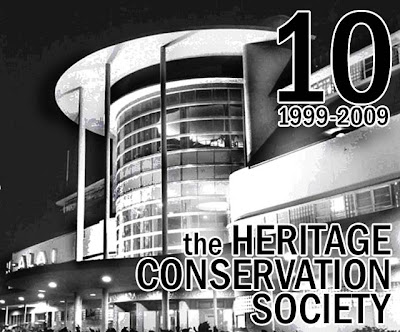
The
Heritage Conservation Society (HCS) began in 1994 as an
ad hoc group known as
Save Manila Bay! As far back as the Aquino administration, a group of concerned citizens was already clamoring for the conservation of our built heritage, settings and sites. A well-connected constructing company was about to reclaim Manila Bay, and the Secretary of Public Works already had plans of constructing a fly-over on Quirino Avenue and Roxas Boulevard. Doris Magsaysay Ho, Bambi Harper, Edda Henson, to name only a few concerned citizens, were up in arms and formed the
Tourist Belt and Business Association to save Manila Bay from commercial depredation.
The HCS was formally established on 21 June 1999. The incorporating trustees were Doris Ho, Joan Orendain, Bambi Harper, Paulo Alcazaren and Augusto Villalon. Evident it is that the objectives stated by the Society were the results of more than a decade of battles and sustained advocacy.
The main issue of the day was the July 2000 demolition of the Jai Alai Building, an Art Deco treasure designed by noted American architect Welton Becket, on the orders of Mayor Lito Atienza. For more information on this, read
The Game's Over: A link with the past goes as Manila's Jai Alai stadium is torn down.
Villalon says, "The useless demolition of Manila’s Jai Alai building in June 2000 was the catalyst that opened Filipino eyes to the fragility of the remaining symbols from our past."
"The year 2001 was when heritage conservationists flexed their muscles, forged partnerships with environmentalists to protect heritage, and tested the effectiveness of Philippine law in preserving the nation’s cultural heritage," Villalon recounts in his article
Getting our heritage to survive the ages.
In the spirit of continuity, the 2002 HCS Board emphasized the importance of advocacy work because of the belief that before “coming to blows,” we first have to exhaust all means to inform local and national government officials, communities, architects and engineers, developers, lawyers, students, even the media about the value of heritage – what heritage is and why we are battling to conserve it.
Heritage conservation maintains links with our past by preserving significant structures, historical and cultural sites and settings. Our built heritage is evidence of our political history and socioeconomic development; it reflects our shared values, and is tangible proof of Filipino excellence and creativity.
Far from converting anything of our heritage into a museum, the HCS affirms that an efficient 21st century lifestyle can take place in the same urban and architectural envelope created by earlier generations. Built heritage can be recycled for contemporary, adaptive re-use, thereby preserving the cultural charm and traditional character of our cities and towns. Heritage conservation enhances progress and modernization : from urban revitalization and community housing, to the revival of traditional crafts and the stimulation of entrepreneurial activities. It awakens our
pride of place, arousing cultural and historical awareness, which often advances cultural tourism.
Ten years after its creation, HCS continues to dream and work for "a Filipino society that values and preserves its cultural heritage in order to instill
pride of place and strengthen Philippine national identity." With the help of every Filipino, that dream will become a reality.
Join us for a Benefit Dinner on 20 June 2009 at My Mother's Garden (the residence of Pablo Antonio, National Artist for Architecture), 2650 Zamora Street, Pasay City as the Heritage Conservation Society celebrates a decade of enthusiastically promoting
pride of place in the entire country. Please contact the Secretariat 5212239, 5222497, (0917) 8668853 or (0922) 8712061 for more information.
 Pancit or pansit is a very popular noodle dish of the Philippines. In fact, the Philippines has a lot of noodle dishes. After the longganisa series (which I have yet to complete), it's now time to talk about pancit, mami, at iba pa! Many localities have their own noodle dishes, pancit being the most popular of course.
Pancit or pansit is a very popular noodle dish of the Philippines. In fact, the Philippines has a lot of noodle dishes. After the longganisa series (which I have yet to complete), it's now time to talk about pancit, mami, at iba pa! Many localities have their own noodle dishes, pancit being the most popular of course.














